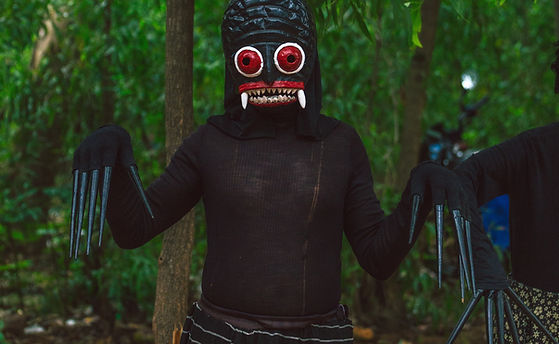
.jpg)
Baha Artists

Kristibhumi


Birbhum has rich cultural legacy. Diverse cultural heritage and folklore are prevalent here. Some of such significant aspects are Baul, tribal culture, Bhadu, Bhanjo, Raibese, Bajikar, Patua, Dharam puja, Gajan and Bolan.

Bauls
Performance of Baul song at Joydev Fair, 2023
.jpg)


Baul is usually understood to mean religious eccentricity. Bauls are those people who seek, by contemplation and self surrender, to obtain unity with or absorption into the absolute. Baul is not only a folk song, rather it is a journey to transmit beyond mundane world to step into eternity. The folk songs sung during this process of transmission are called Baul songs. There are two different styles of Baul song – one pertains to eastern Bengal and another to Rarh Bengal. Birbhum is the homeland of this Rarh Bengal style. Rabindranath Tagore himself reconciled both the styles.
Where to find Baul: In Birbhum, Bauls can be located everywhere, be it Sati Pith, Sonajhuri haat, roads or streets. One can hear the tune of Bauls everywhere in this district throughout the year. Joydeb Fair is famously known as the union place of Bauls. Bauls are found singing in the Poush Mela and other fairs, though the Baul Akhara can now only be located at Joydeb.
Baul


It is said that the bridegroom died in the way while coming to wed Bhadreswari, the daughter of Panchokot King Nilmani Singh Deo. Bhadreswari unfortunately committed suicide. In memory of the said incident, Bhadu songs are sung. Bhadu is actually a Goddess of this earthly world rather than that of a heavenly Goddess.The Bhadu song depicts the daily sorrow and merriment of life of the downtrodden society of Birbhum, Bankura, Purulia and conveys the contemporary social messages.
Basically, Bhadu songs are sung in the Bengali month of Bhadra. The singers roam door to door with harmonium, tabla, dohar, etc. They carry a small idol of Bhadu and a basket to collect rice. The dancing form while singing Bhadu song is also unique in itself.
Bhadu Gaan
Bhadu Gaan
.jpg)
Raibenshe


Raibenshe
It is a district dance form which was traditionally performed by the expert soldiers from the community of Dom, Bauri and Bhalla Mal during the time of Pal and Sen empire. These brave soldiers started indulging in heinous robberies. The District Magistrate of Birbhum of that time, Gurusaday Dutta, took initiative to revert these brave soldiers to their former glory and he could elevate their performance in gymnastics, Lathikhela and Ranpa dancing to an artistic level. The Bratachari Samiti was also established in 1934 at the initiative of Gurusaday Dutta. Raibenshe is now an internationally acclaimed dance form.
It is Gurusaday Dutta, the then District Magistrate, who introduced this distinct dance form at Charkol village at Nanoor assisted by Rampada Pramanik – Gobardhan Pramanik. Few such dance groups can be found now at Nanoor, Ahmedpur etc. Since Raibenshe is not a festival-based celebration, it can be witnessed in many programmes throughout the year.



Bahurupi Village Bishaypur
Bishaypur is a small village in the Labpur block, and the main feature of the village is that most of the families living here belong to the ancient multifaceted folk tradition. That is why this village is called the village of polymorphs. All polymorphs of this village are called Chowdhury (byadh). Polymorphism is an ancient culture of this country. A person manifests himself in one form each day. Among the popular forms of Birbhum are Rama, Ravana, Taraka Rakshasi, Tarasundari etc. Apart from polymorphism, the people of this Byadh tribe used to consider hunting as one of the means of livelihood till some time ago.
How to go: Bishaypur is about 8 km from Labpur via Gopalpur Valas. When you reach there, you will understand the life practices of various communities throughout Bishaypur. On the way to Laghosa village, you can see the tomb of Rangalal Mukhopadhyay, the author of the encyclopedia, and Valas village, known as the village of revolutionaries.
When: There is no specific time or festival to see acts of polymorphism. But in Vijaya Gajan, there is a practice of dharma puja. Autumn to spring is generally considered the ideal time to see acts of polymorphism.
.jpg)
Bahurupi

Gajan


Dharampujo: Dharma or Dharam Thakur is regarded as the most ancient God worshipped in the rural Bengal. Though this religious belief subsequently yielded to the Surya–Shiva-Buddhist tradition, the tradition or culture is still being followed by the worshippers of this belief. This marks the Aryan impression of the puja. Dharam Than can be located almost in every part of the district like Mallickpur near Suri, Tantipara, Purandarpur, Bele near Ahmedpur, etc. It is believed that Bele Dharmaraj has the healing power to cure arthritis and with this belief, Kazi Nazrul Islam visited Bele Dharmaraj for treatment of his wife, Pramila. Dharampujo is celebrated in Baisahkhi Purnima or Buddha Purnima and is often acknowledged as a grand festival in rural area.
Gajan: According to one thought, the term “Gajan” derives its name from “Gorjan” (roaring). Another school of thought says that “Ga” means village and “Jon” means people and thus Gajan is a festival where the village people gather together. Gajan is held on the festival of Dharma Thakur, likewise it is also held in Chaitra Sankranti in Shiva temples.
Bolan: Bolan is a folk drama based on traditional and mythical faith performed during Dharam Pujo or Gajan. It is very popular in the remote villages situated in Birbhum – Mushidabad border area.
Dharam Pujo – Gajan – Bolan



